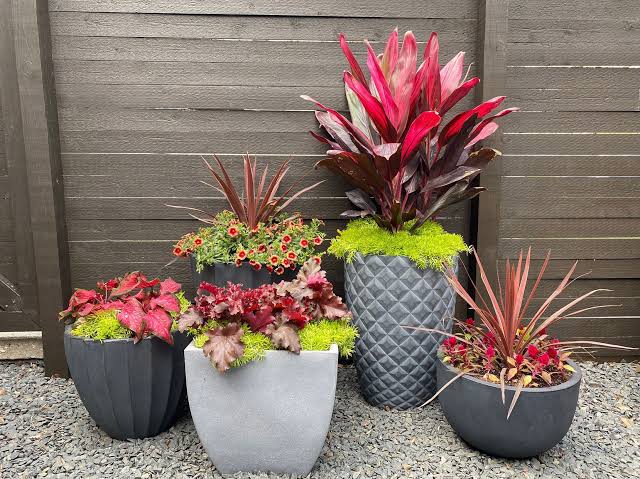Garden planters have become essential for modern gardening, whether you’re working with a sprawling backyard, a modest patio, or a small city balcony. These versatile containers make it possible to grow flowers, vegetables, herbs, and decorative plants almost anywhere—even in places where traditional garden beds aren’t an option. If you’ve wondered how to choose the right planter, what soil to use, or how to keep container plants thriving, this guide covers Everything You Need to Know About Garden planters in one place.In this complete guide, you’ll discover the best materials, designs, placement strategies, soil tips, watering techniques, and maintenance secrets to help you create lush, eye-catching displays that work in any climate or living space.🌸 Why Garden Planters MatterGarden planters do much more than hold soil—they allow you to control your gardening experience with precision. They let you:Grow plants in limited or urban spacesAdjust soil type and drainage for each plantMove plants to optimize sunlightDecorate outdoor living areas with styleExtend or personalize your growing seasonExperiment with different plant combinationsUnderstanding Everything You Need to Know About Garden planters helps you maximize these benefits while keeping your plants healthy and thriving.🪴 Types of Garden PlantersOne of the first steps in choosing garden planters is deciding which material best fits your needs. Each type offers unique advantages depending on your climate and plant preferences.🌿 1. Terracotta PlantersTerracotta is a timeless favorite for gardeners around the world.Pros:Breathable, allowing roots to breatheStylish and natural-lookingIdeal for Mediterranean plants like rosemary or lavenderCons:Can dry out quicklyBreakable in freezing temperaturesGreat for: U.K. gardens, indoor herbs, and dry-climate plants.🌝 2. Plastic or Resin PlantersLightweight and budget-friendly, these planters are popular for casual gardeners.Pros:Retain moisture longerLess prone to cracking in cold weatherEasy to move aroundCons:Can fade in direct sunlightGreat for: U.S. South, Canadian patios, beginners, and balcony gardening.🌲 3. Wooden PlantersWood creates a warm, rustic aesthetic that complements many plants.Pros:Excellent insulation for rootsAttractive designDurable when made from cedar or redwoodCons:May rot over time without proper treatmentGreat for: Vegetables, small shrubs, and multi-plant arrangements.⚙️ 4. Metal PlantersModern and sleek, metal planters make a bold statement.Pros:Very durableStylish and contemporaryWorks well in modern gardensCons:Can overheat in strong sunRequires insulation for root protectionGreat for: Architectural plants and urban designs.🪴 5. Concrete or Stone PlantersHeavier and more permanent, these planters bring stability.Pros:Extremely durableInsulate roots wellDon’t topple in strong windsCons:Heavy and difficult to moveGreat for: Large shrubs, tall grasses, and permanent installations.🌼 Choosing the Right Planter SizeA crucial part of Everything You Need to Know About Garden planters is understanding planter size.✔ Small Pots (4–8 inches)Good for herbs, succulents, and seedlings.✔ Medium Pots (10–14 inches)Ideal for flowers, compact veggies, and mixed annuals.✔ Large Planters (16+ inches)Perfect for tomatoes, shrubs, fruit trees, or multi-plant displays.Rule of thumb: Bigger is almost always better. Larger planters provide more soil, better drainage, and more stable temperatures.🌱 Selecting the Best Soil for PlantersSoil is one of the most important aspects of container gardening.🌿 Use a High-Quality Potting MixNever use native garden soil—it’s too dense for containers.A good potting mix includes:Peat or coco coir for moisturePerlite or vermiculite for airflowCompost for nutrients❌ Avoid:Clay soilSoil from your yardHeavy mixes without drainageGood soil breathes, drains, and supports consistent root growth.🌞 Perfect Light Placement: Sun, Shade & Everything BetweenKnowing where to place your planters is essential.🔆 Full Sun (6–8 hours)TomatoesGeraniumsPetuniasLavender🌤 Partial Sun (3–5 hours)BasilImpatiensFuchsiasBegonias🌑 Full Shade (1–2 hours)HostasFernsHeucheraWhen learning Everything You Need to Know About Garden planters, understanding sunlight needs is one of the most important skills.💧 Watering Garden Planters the Right WayWatering is one of the biggest challenges in planter gardening.✔ Water DeeplyWater until moisture drains out the bottom.✔ Check Soil RegularlyStick your finger into the soil—if dry 1–2 inches down, water.✔ Water in the MorningReduces evaporation and prevents root rot.✘ Avoid OverwateringMany plants die from too much water, not too little.✔ Consider Self-Watering PlantersPerfect for busy gardeners or hot climates.🌿 Fertilizing Planter GardensPlants in containers need more frequent feeding because nutrients wash out with each watering.✔ Use Slow-Release FertilizerLasts for months and supports steady growth.✔ Add Liquid Fertilizer Every 2–4 WeeksEspecially for heavy feeders like tomatoes and petunias.✔ Choose Specialty Fertilizers When NeededAcid-loving plants (blueberries, gardenias)Bloom boosters for flowersOrganic options for herbs and veggiesFertilizing regularly is a major part of Everything You Need to Know About Garden planters for healthy, vibrant displays.🌸 Design Secrets for Stunning Planter DisplaysProfessional gardeners often use one design method:🌟 The “Thriller–Filler–Spiller” FormulaThriller: Tall focal plant (e.g., dracaena, salvia)Filler: Medium plants for volume (e.g., begonias, coleus)Spiller: Trailing plants that drape (e.g., ivy, lobelia, sweet potato vine)This simple formula creates rich, layered, magazine-worthy planters.🐝 Plants That Attract Pollinators to Your PlantersGarden planters aren’t just decorative—they can support bees, butterflies, and hummingbirds.Best Pollinator-Friendly Plants:ConeflowerZinniasLavenderFuchsiaSalviaMarigoldsBee balmBy choosing pollinator-friendly plants, you improve both your garden and local ecosystems.❄️ Seasonal Planter Ideas (Spring, Summer, Fall, Winter)Part of understanding Everything You Need to Know About Garden planters is knowing how to rotate them seasonally.🌸 SpringTulipsDaffodilsPrimroses☀ SummerPetuniasHerbsTomatoes🍂 FallChrysanthemumsOrnamental cabbagePansies❄ WinterHelleboresEvergreen branchesWinter heatherPlanters can provide beauty 365 days a year!💡 Practical Tips for Garden Planter SuccessUse pots with drainage holesAdd a layer of small stones to improve drainageRotate planters for even sunlightGroup planters together to create microclimatesClean pots between seasons to prevent diseaseRepot root-bound plants yearlyElevate planters with pot feet to avoid waterloggingThese small habits make a huge difference in long-term plant health.🌿 Conclusion: Everything You Need to Know About Garden PlantersGarden planters offer endless opportunities to grow, decorate, and personalize your outdoor space. Whether you’re a beginner or an experienced gardener, understanding Everything You Need to Know About Garden planters helps you create thriving, beautiful displays that match your climate, space, and lifestyle.From choosing materials and sizes to mastering watering, soil selection, and plant combinations, planters make gardening accessible to everyone—whether you live in the U.S., U.K., or Canada. With the tips and strategies in this guide, you’re ready to design planter arrangements that bloom beautifully season after season.

